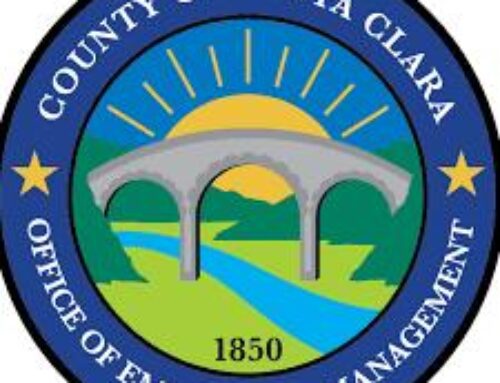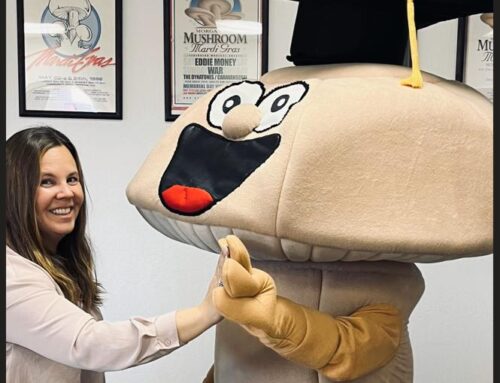$198M provides facility improvements, IT and equipment upgrades
Published in the Oct. 14-27, 2015 issue of Morgan Hill Life
By Marty Cheek

Photo by Marty Cheek
San Martin/Gwinn teacher Jose Anaya and Principal Claudia Olaciregui celebrate the school’s Measure G-funded environmental science courtyard with third-graders Mason Woods, Cressida Hansen, Adolfo Santos and Aubrey Monaco.
Several third-graders at San Martin/Gwinn Environmental Science Academy peered through a chain-link fence and watched construction workers installing two new outdoor science labs in the school’s newly-built environmental courtyard. When the children learned how the recent facility and information technology improvements at their school came from Measure G bond funds, they said they appreciate the initiative to upgrade all Morgan Hill Unified School District campuses for 21st-century learning.
Among them was Mason Woods who said the taxpayers providing Measure G funding will make he and his fellow students “better people.”
Measure G, which voters approved in November 2012, to raise $198 million for facility improvements and IT infrastructure and digital equipment upgrades. Homeowners pay about $59 per $100,000 in assessed value. In February 2013, the first series of bond sales, known as Series A, was released to the tune of $55 million.
MHUSD Superintendent Steve Betando said that since then much has been done with the money to bring upgrade facility and improve IT in the district where the average age of its 14 school campuses is 40 years. Much of the messy construction work was done during summer months.
“We’re really refacing the entire district, bringing the infrastructure up to modern standards and to set it up for the technology,” the superintendent said. “And then there’s the conservation and environmental considerations for instructional design, for curb appeal, for comfort in the work place.”
Many of the Measure G projects have been overseen by Casino Fajardo, director of construction and modernization at MHUSD. San Martin/Gwinn was one campus that saw a major construction this summer. Among the projects is the environmental courtyard which students will use to learn about ecology and energy in the new science labs. A “human sun-dial” etched into the paver stones will make it fun for kids to learn to tell time using an ancient astronomical-based technology.

Construction workers build one of two new outdoor science labs at the San Martin/Gwinn Environmental Science Academy. The project is paid for through Measure G funds.
Photo by Marty Cheek
Another campus that experienced dust from construction this summer was P.A. Walsh STEAM Academy. The school used Measure G funds to build a better traffic flow system and additional parking with 40 added stalls. To highlight the school district’s desire to focus on ecologically-friendly initiatives, P.A. Walsh, which focuses studies on science, technology, engineering, arts and mathematics, received a bioswale landscaping drainage system so rain water can seep into the soil and not overflow the storm system. The school received new bike racks and skateboard docks for students, easing traffic congestion through their use. An electric car charging station was also installed in the parking lot, with a possible second one coming in the near future, Fajardo said.
“Everyone commutes and electric vehicles are becoming more common now,” he said. “Tesla is here in Fremont. It’s easy to put the conduits and power in now. If it changes out later, great, but I wanted to make sure we can accept those things so that if (electric cars) do go full boom, we can bring that service to the community.”
Fajardo, who went through the MHUSD system and graduated from Live Oak High School, has a son who will be entering the district as a kindergarten student next year. He believes the district’s emphasis on energy savings and environmental conservation sends a message to students to consider their own impact on future generations.
Significant progress on construction of a new multi-use building took place at Charter School of Morgan Hill, located north of Morgan Hill in the former Encinal School site, Fajardo said. The roofing and siding is essentially done and workers are finishing the floor of the $5 million project, which is expected to open in Januar
. Paradise Valley and Nordstrom elementary schools will also get their own new multi-use buildings in the next few years.
“We did a really objective needs analysis — and multi-use was one of the (facility items) that we decided was important because it can always be used for many things including after-school events or renting it out,” he said.

A worker puts up support poles for a shad structure at San Martin/Gwinn Academy. Photo by Marty Cheek
Measure G funds have gone into upgrading the information systems at elementary, middle and high school campuses, with many classrooms being rewired with fiber-optics and wireless communication services that allows students and teachers to access a gigabit-speed networks. Most students in the district have also received Chromebooks, helping children from financially-struggling families to cross the “digital divide” and be better able to compete in a world where computer knowledge is mandatory for career opportunities.
The district decided to make the IT system flexible to adapt to new digital devices in the coming years, Fajardo said. It is also looking at partnering with Silicon Valley companies such as Google and Cisco to enhance classroom learning math and logic with computer programming curriculum. One proposal in the works is the ability to do videoconferencing and streaming with classrooms in other countries, allowing for the eventual possibility of Morgan Hill students making friends through video-phone chats with foreign students.
Britton Middle School, the oldest campus, is at the start of a major upgrade that will include a new administration/library building intended to be also used for non-school-related community events.
The former Central High School a few blocks north of downtown Morgan Hill also is now going through planning stages by district staff to transform it into career-tech center. The district is in the early stages of talking with Morgan Hill Chamber of Commerce members and local business owners to develop a mixed-funding for this project using Measure G and private money. One of the ideas proposed for this facility is a culinary academy for students interested in food services careers, Fajardo said.
With the eventual sale of Series B bonds and financial savings through re-financing and investment of Measure G dollars, Board President Bob Benevento said he hopes to see the district develop facilities that serve students who do not necessarily want to go to higher education but want to advance their job training opportunities.
“I believe more dollars from Measure G need to be invested in career technical facilities or vocational education facilities,” he said. “Not every child is going to go to college, but every child needs to have a career — and there are great careers to be had in the trades and the crafts.”






